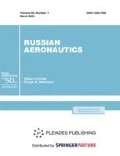Abstract
Techniques of adaptive, situational, and reflexive control of information resources of telecommunication system were developed to ensure the information security while preserving the efficiency of information exchange under conditions of information technical impacts. The possibilities of reducing delays in message transmission have been assessed under the protection implementation during an information conflict by the antagonism scheme. A comprehensive method is justified for control the information resource in order to protect telecommunication systems of aviation monitoring complexes from intentional interferences created by spatially distributed ground and air-based jammers.



Similar content being viewed by others
Change history
09 November 2020
The TeX presentation of formulas was updated in HTML file.
03 December 2020
An Erratum to this paper has been published: https://doi.org/10.3103/S1068799820030381
REFERENCES
Boev, S.F., Rakhmanov, A.A., and Sloka, V.K., Net-Centric Systems of Regional Level of a Real Time Scale, Mekhatronika, Avtomatizatsiya, Upravlenie, 2009, no. 3, pp. 64–68.
Rakhmanov, A.A., Principles and Approaches for Conceptual Design of Network Centric Systems, Izvestiya YuFU. Tekhnicheskie Nauki, 2010, no. 12 (113), pp. 125–134.
Mikhailov, R.L., Radioelektronnaya bor’ba v vooruzhennykh silakh SShA (Electronic Warfare in the U.S. Armed Forces), St. Petersburg: Naukoemkie Tekhnologii, 2018.
Kucheryavyi, A.E., Prokop’ev, A.V., and Kucheryavyi, E.A., Samoorganizuyushchiesya seti (Self-Organizing Nets), St. Petersburg: Lyubavich, 2011.
Makarenko, S.I., Informatsionnoe protivoborstvo i radioelektronnaya bor’ba v setetsentricheskikh voinakh nachala XXI veka (Information Confrontation and Electronic Warfare in the Network Centric Wars in the Beginning of the XXI Century), St. Petersburg: Naukoemkie Tekhnologii, 2017.
Sovremennaya radioelektronnaya bor’ba. Voprosy metodologii (Modern Radio-Electronic Warfare. Methodology Questions), Radzikvoskii, V.G., Ed., Moscow: Radiotekhnika, 2006.
Davydov, A.E., Maksimov, R.V., and Savitskii, O.K., Zashchita i bezopasnost’ vedomstvennykh integrirovannykh infokommunikatsionnykh sistem (Protection and Security of Departmental Integrated Info-Communication Systems), Moscow: Voentelekom, 2017.
Khripushin, D.V. and Chikin, M.G., The Estimation of Effectiveness of Joint Use of Multi-Type Facilities of Radio Cancellation of Radio Communication with Retransmission, Radiotekhnika, 2007, no. 7, pp. 45–48.
Chikin, M.G., Features of Using the Semi-Markovian Process Apparatus to Evaluate the Radio Jamming Efficiency of Directions of Radio Propagation, Radiotekhnika, 2005, no. 9, pp. 97–101.
Borisov, V.I. and Zinchuk, V.M., Pomekhozashchishchennost’ sistem radiosvyazi. Veroyatnostno-vremennoi podkhod (Noise Immunity of Radio Communication Systems. Probabilistic and Time Approach), Moscow: Radio i Svyaz’, 1999.
Baturin, Yu.O., Zaitsev, I.V., Poddubnyi, V.N., Pustovoitov, Yu.I., and Chikin, M.G., The State and Directions of Developing the Methodology of Justification of Radio Communication System Radio Suppression Equipment Requirements, Radiotekhnika, 2010, no. 6, pp. 80–86.
Zhidko, E.A., Logiko-veroyatnostno-informatsionnyi podkhod k modelirovaniyu informatsionnoi bezopasnosti ob’ektov zashchity (Logic-Probabilistic-Information Approach to Modeling the Information Security of Objects under Protection), Voronezh: VGTU, 2016.
Gnedenko, B.V. and Kovalenko, I.N., Vvedenie v teoriyu massovogo obsluzhivaniya (Introduction to the Queueing Theory), Moscow: Nauka, 1987.
Balybin, V.A., Donkov, Yu.E., and Linnik, I.V., Radio Suppression of Modern Radio Communication Systems, Voennaya mysl’, 2006, no. 8, pp. 27–31.
Blokh, E.L., Popov, O.V., and Turin, V.Ya., Modeli istochnika oshibok v kanalakh peredachi diskretnoi informatsii (Models of Error Source in Discrete Channels of Information Transmission), Moscow: Svyaz’, 1971.
Zhidko, E.A. and Razin’kov, S.N., Model of Security and Information Protection Subsystem of Communication and Control System of a Critical Object, Sistemy Upravleniya, Svyazi i Bezopasnosyti, 2018, no. 1, pp. 122–135.
Novikov, D.A., Chkhartishvili, A.G., Refleksivnye igry (Reflexive Games), Moscow: SINTEG, 2003.
Shashikhin, V.N., Formation of a Desired Spectrum in the Closed-Loop System with Decentralized Control of a Flight Vehicle, Izv. Vuz. Av. Tekhnika, 2002, vol. 45, no. 4, pp. 27–32 [Russian Aeronautics (Engl. Transl.), 2002, vol. 45, no. 4, pp. 32–40].
Nasyrov, I.K. and Andreev, V.V., Optimal Estimation of Parameters of Pseudorandom Signals of Nonlinear Dynamic Systems, Izv. Vuz. Av. Tekhnika, 2018, vol. 61, no. 4, pp. 162–165 [Russian Aeronautics (Engl. Transl.), 2018, vol. 61, no. 4, pp. 692–696].
Kokuev, A.A., Kochkarov, A.A., Makarov, K.V., and Timoshenko, A.V., Optimization of Airborne Meteorological Airspace Monitoring Complexes Flight Routes, Uspekhi Sovremennoi Radioelektroniki, 2017, no. 11, pp. 36–42.
Razin’kov, S.N., Nikitin, R.O., and Lubavsky, A.P., Applications and Ways of Improvement of Ultra-Broadband Radio Communication Systems, Elektrosvyaz’, 2018, no. 7, pp. 53–57.
Malyuk, A.A., Informatsionnaya bezopasnost’. Kontseptual’nye i metodologicheskie osnovy zashchity informatsii (Information Security. Conceptual and Methodological Framework for Information Protection), Moscow: Goryachaya Liniya-Telekom, 2004.
Mel’nikov, V.V., Bezopasnost’ informatsii v avtomatizirovannykh sistemakh (Information Security in Automated Systems), Moscow: Finansy i Statistika, 2003.
ACKNOWLEDGEMENTS
The paper was prepared with the financial support of the Russian Venture Company AO "RVK".
Author information
Authors and Affiliations
Corresponding author
About this article
Cite this article
Kochkarov, A.A., Razin’kov, S.N., Timoshenko, A.V. et al. Comprehensive Method of Information Resources Control Ensuring the Security of Telecommunication Systems of Aviation Monitoring Complexes. Russ. Aeronaut. 63, 347–356 (2020). https://doi.org/10.3103/S1068799820020233
Received:
Revised:
Accepted:
Published:
Issue Date:
DOI: https://doi.org/10.3103/S1068799820020233




